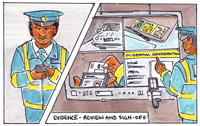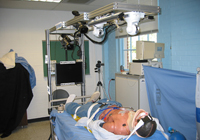Q & A with Diane H. Sonnenwald
Professor Sonnenwald joins the Royal School of Library and Information Science from the University College Dublin and will start teaching in the autumn.

Professor Sonnenwald conducts research on collaboration, information behavior and collaboration technology in a variety of contexts, including inter-disciplinary and inter-organizational collaboration in police work, emergency healthcare, academia and industry.
The 13th of May beginning at 15:00 she will give her inaugural lecture “Visioning Studies: A Socio-Technical Approach to Designing the Future” alongside RSLIS’ two other new professors – Morten Hertzum and Hans Dam Christensen.
What does your research evolve around?
My overall approach to research is “use-inspired”, a term introduced by Donald Stokes. That is, in my research I strive to increase our understanding and improve practice.
An overarching focus of my “use-inspired” research has been collaboration and information sharing from social and technical perspectives. Questions investigated include: What are social practices that facilitate collaboration and information sharing? What technologies can facilitate collaboration today and in the future?
I’ve worked with various groups to help them improve collaboration within and across institutions, and I’ve worked with colleagues in computer science and other disciplines to design technology to facilitate collaboration in new ways.
A few years ago when discussing my research with a colleague, the term “visioning study” was coined to describe my approach.
Visioning studies
Agencies and institutions that financially support research, including computer science research, want to avoid funding research that will not eventually be useful in some way.
To address this concern, I’ve been collaborating with computer science researchers to investigate the potential of new technologies they are developing. A vision describing the potential future use of a technology is created, and this vision is investigated in collaboration with many stakeholders. The goal is to identify potential relative advantages and disadvantages, including positive or negative consequences of the technology, and ways to maximize the potential benefits of the technology as early as possible in the research cycle.
When doing this I focus on human and organizational perspectives, and the interplay of people, technology, information and social structures. Thus human and organizational perspectives are brought in at the beginning of the computer science research process, and not after the research and development has been done and the technology is deployed out in the field.

A scenario from the mobile police work project (project funded by the Motorola Foundation)
Emergency health care and police work
For example, I have been working with computer scientists and with emergency medical physicians to look at whether 3D telepresence technology could be helpful and effective in connecting paramedics in the field on emergency calls with specialists at hospitals.
In both projects the new technologies will require broad infrastructure enhancements and may literally impact lives. Much is at stake.

The experimental setup for the paramedic project (Project funded by the National Library of Medicine (US))Another project that I am working on is looking at the adoption and use of future mobile technology in police work from the perspective of police officers.
What else are you working on at the moment?
Theory development
I am currently editing a book on theory development. Colleagues from around the world have contributed chapters discussing how they develop and use theory. Each chapter provides a personal perspective on theory development and use.
When we write our research papers and books, we typically provide a limited - or no - discussion about frustrations and joys we encountered while conducting the research. There is only space for so many words, and there is sometimes a bias towards describing only successes. Thus some of the story is left out. So I asked my colleagues to provide their personal perspectives on their experiences developing theories.
Fact:
For additional information about Professor Diane H. Sonnenwald, her work and background, see her profile on www.researchgate.net.The book covers theory development across the information sciences. For example, chapters discuss theory development in bibliometrics, cultural heritage, design, human computer interaction, human information behavior, interactive information retrieval, relevance, scholarly communication and webometrics. Different types of theories and theories with different purposes are included.
I’m writing a chapter synthesizing the theory development and use processes described by the other chapter authors. I hope the book will help reduce some of the mystery surrounding theory development, and increase people’s confidence in their abilities to develop and use theory.
I’ll also be teaching the required master’s course on theories and traditions in information and cultural studies with Professors Beth Juncker and Birger Hjørland this autumn. I’m looking forward to helping to guide students as they explore the different purposes and uses of theories.

One of the rare books used in the Rare book project (project funded by the HW Wilson Foundation).
Human-Rare Book Interaction
Have you ever had the opportunity to hold and touch a rare book hundreds of years old? Few people get such an opportunity but when they do, it is often an enriching experience. How can we provide this type of opportunity to more people without endangering our rare books?
A pilot project that I have started investigates how people interact with rare books and how they perceive that interaction. An ultimate goal is to build a physical-virtual rare book that could provide an interactive experience similar to an actual rare book.
ASIS&T
I continue to be involved with ASIS&T, the Association for Information Science and Technology. As the first person working and living outside North America to be elected President of ASIS&T and serving as Immediate Past President until November 2013, I continue to play a role in increasing international aspects of the organization. Other faculty at IVA are also active and valuable members of ASIS&T, and I hope more students can become involved with ASIS&T and benefit from the many activities ASIS&T supports.
Af Christian Baun
